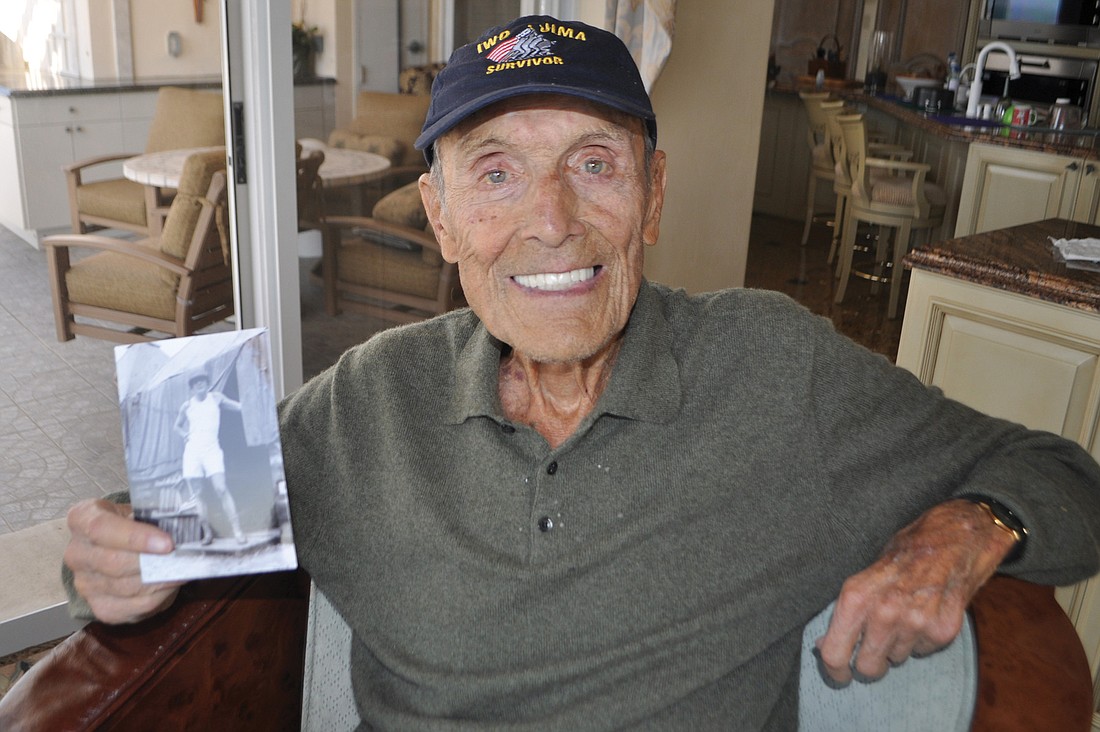- April 19, 2024
-
-
Loading

Loading

Marty Samowitz watched the flag rise over Mount Surabachi and thought it ordinary.
It was Feb. 23, 1945, four days after the start of the Battle of Iwo Jima.
Samowitz was among the American troops who fought their way to the top of the mountain.
“We were just fooling around because we were happy to get to the top,” Samowitz said.
As they sat smoking, they saw five Marines and a Navy corpsman raise the flag.
Associated Press photographer Joe Rosenthal snapped the photo of the flag raising that would win him a Pulitzer Prize.
“It became an iconic symbol of the worst war in history,” Samowitz said. “But they would have never dreamed that it would become that way.”
At 98, Samowitz is now the oldest-known survivor of the pivotal Battle of Iwo Jima. Feb. 19 will mark 68 years since the beginning of what was the first American attack on Japanese home turf during World War II.
In August 2010, Samowitz attended what the Iwo Jima Survivors Association in Branford, Conn. called its 65th Final Reunion — the “final” because the number of survivors was so low and dwindling.
The year before, Samowitz had hosted survivors on his boat, “Footloose.” Only 10 survivors were able to attend. Samowitz recalled reunions decades earlier that drew thousands.
The final reunion had a candlelight service in honor of members’ comrades who lost their lives on Iwo Jima and the survivors who had since died. A table remained empty in honor of those who were unable to attend.
On Oct. 3, 2010, Samowitz reflected on the final reunion in an email to fellow survivors that he called “Idle thought on a beautiful Sunday afternoon in Atlantic City, N.J.”
The Journal of the Iwo Jima Survivors published it:
It stated, in part:
“Can you believe it’s been more than 65 years since D-Day when we stormed the beaches on that God-forsaken black sand island off Japan and lost almost 7,000 of our comrades? The candlelight service for our departed, who lost their lives then, and in the intervening years, was so moving that these hardened eyes of mine could not help but shed a tear.”
…
Samowitz is nearly a decade older than many of the Iwo Jima survivors who gathered each year.
He was 27 when the Japanese bombed Pearl Harbor and enlisted shortly thereafter in the Air Force. He was fighting in the Pacific as part of the Seventh Fighter Command, 20th Air Force, when he got orders to ship out to attach to a Marine unit.
The Marines he served alongside were young, mostly in their late teens or early 20s. Decades later at reunions, occasionally a Marine veteran would ask him, “Remember me? We shared a foxhole?”
In truth, their young faces blended together.
As the troops prepared to invade Iwo Jima, a general told them the battle would be over in two days.
“Thirty days later, we were still living in foxholes,” Samowitz said.
The battle that began Feb. 19 wouldn’t end until March 26.
Samowitz remembers the vague feeling of fighting his way up the mountain.
“You feel like you can survive; you’re young,” he said. “In war, it was always the guy next to you who got wounded or killed.”
On D-Day “plus one,” he saw a wounded Marine being carried down the mountain. The Marine asked Samowitz what he was doing with a popgun. He told him he should have a BAR rifle, so they switched right then, before the Marine was carried away.
Samowitz had never fired the heavy weapon, but he learned quickly enough.
The troops stayed behind on Iwo Jima to train for the invasion of mainland Japan, but after President Harry Truman ordered the atomic bombing of Hiroshima, followed by Nagasaki, in August 1945, the Japanese quickly surrendered.
Samowitz remembers everyone else thinking they would get to go home immediately.
He asked them: “Dummies, how are they going to get enough ships?”
They had to wait a few months before they could return.
Samowitz was discharged on the West Coast, along with a couple of his buddies. They bought new clothes. Then, they threw away their military uniforms and took the train back home to New York.
…
Some Iwo Jima survivors have organized charter flights to return to the island for past anniversaries. They asked Samowitz to join them but he declined.
“I didn’t like it the first time,” he told them. “I’m not going to like it the second time.”
Like most of his fellow veterans, Samowitz didn’t spend the ensuing decades reliving Iwo Jima.
Upon his return, he took a job at a shoe store. He went into the business, himself, and built the northeastern chain Marty’s Shoes.
Samowitz believed that Iwo Jima groups grew over the past couple of decades as survivors retired.
“For years and years and years, I didn’t think about Iwo Jima,” he said. “It was only later that you think about what it was and what those days were.”
Samowitz has an “Iwo Jima Survivor” cap that he wears sometimes.
Occasionally, he encounters a person who has never heard of Iwo Jima, nearly seven decades later.
Often people notice and send their kudos or buy him a drink.
Or, sometimes, they simply say:
“Thank you for your service to our country, sir.”